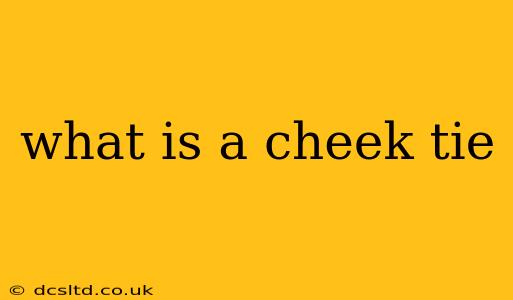A cheek tie, also known as ankyloglossia of the buccinator muscle, is a condition where a short, thick band of tissue (frenulum) restricts the movement of the cheeks. Unlike a tongue tie (ankyloglossia), which affects the tongue's mobility, a cheek tie limits the cheeks' ability to move freely, potentially impacting various oral functions. This relatively less-discussed condition can have significant consequences for breastfeeding, feeding in babies, speech development, and even oral health in older children and adults.
What Causes a Cheek Tie?
The exact cause of cheek ties isn't fully understood, but it's believed to be related to the development of the oral tissues during fetal growth. Genetic factors are suspected to play a role, as cheek ties can sometimes run in families. While not always present at birth, the restrictive band of tissue can sometimes become more noticeable as a child grows. It's crucial to remember that not all restricted cheek movement constitutes a clinical cheek tie; a proper diagnosis requires a qualified professional's assessment.
What are the Symptoms of a Cheek Tie?
Recognizing the symptoms of a cheek tie can be challenging, as they vary greatly depending on the severity of the restriction. Some common signs include:
- Difficulty breastfeeding or bottle-feeding: Infants with cheek ties may struggle to latch effectively, leading to poor weight gain and frustration during feeding. The limited cheek movement can hinder the creation of a proper seal around the nipple or bottle.
- Shallow cheek pads: The cheeks may appear unusually flat or sunken, especially when attempting to suckle or suck.
- Limited cheek movement: Observe whether your child can easily pull their cheeks outwards or upwards. Restricted movement is a key indicator.
- Speech difficulties: In older children, cheek ties can affect articulation and pronunciation, leading to lisps or other speech impediments.
- Dental problems: In some cases, cheek ties might contribute to malocclusion (misalignment of teeth) or affect jaw development.
- Dry mouth: Restricted cheek movement can impair salivary gland function, leading to dryness.
How is a Cheek Tie Diagnosed?
A thorough clinical examination by a dentist, pediatrician, or lactation consultant is essential for diagnosing a cheek tie. They will assess the range of motion of the cheeks, observe feeding patterns (if applicable), and evaluate any potential associated problems. While visual inspection is often sufficient, some practitioners may use additional tools or techniques to confirm the diagnosis.
How is a Cheek Tie Different from a Tongue Tie?
While both cheek ties and tongue ties involve restricted movement of oral tissues due to a frenulum, they affect different structures and result in different symptoms. A tongue tie restricts tongue movement, impacting breastfeeding, speech, and potentially swallowing. A cheek tie, however, primarily impacts cheek movement, affecting primarily feeding and potentially facial development and speech. Both conditions can coexist.
What are the Treatment Options for a Cheek Tie?
Treatment for a cheek tie usually involves a minor surgical procedure called a frenectomy. This involves using scissors or a laser to release the restrictive band of tissue. The procedure is typically quick and minimally invasive, often performed in a doctor's office or clinic under local anesthesia. Post-operative care is usually straightforward. In some cases, non-surgical options like stretching exercises may be considered, but their effectiveness varies.
Does a Cheek Tie Require Treatment?
Whether or not a cheek tie requires treatment depends on the severity of the symptoms and their impact on the individual's daily life. Mild cases that don't cause significant problems may not require intervention. However, if the cheek tie is interfering with feeding, speech development, or oral health, treatment is generally recommended.
What are the Long-Term Effects of Untreated Cheek Ties?
Untreated cheek ties can lead to a range of long-term consequences, including persistent feeding difficulties, speech impediments, dental problems, and even temporomandibular joint (TMJ) disorders in later life. Early diagnosis and treatment can help mitigate these potential risks.
This information is for general knowledge and does not constitute medical advice. Always consult with a qualified healthcare professional for diagnosis and treatment of any medical condition.
